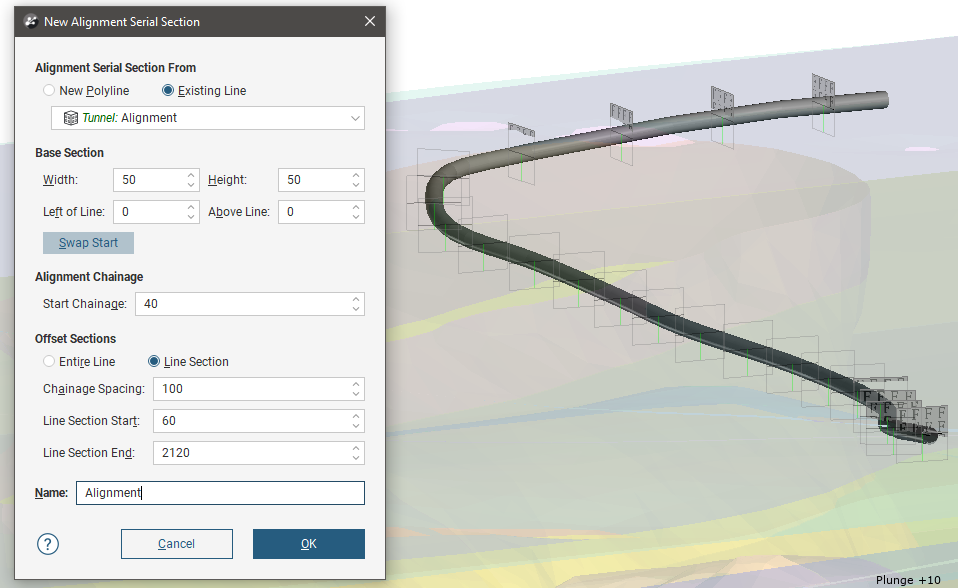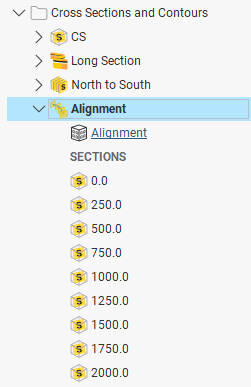Alignment Serial Sections
An alignment serial section can be created using an alignment imported into the Designs folder, a polyline or a GIS line. When creating an alignment serial section from a polyline, you can use an existing polyline or draw a new one.
This topic describes the process of creating and working with an alignment serial section. It is divided into:
- Using a New Polyline
- Using an Existing Line
- The Alignment Serial Section in the Project Tree
- Displaying an Alignment Serial Section
- Exporting an Alignment Serial Section
To create an alignment serial section, right-click on the Cross Sections and Contours folder and select New Alignment Serial Section. The New Alignment Serial Section window will appear. Select whether you will use an existing line or create a new one.
Using an Existing Line
If you select an existing line, planes representing the base section and the offset sections will be added to the scene:

Once you have created an alignment serial section, you can change all settings except the line used.
The Base Section parameters determine the size of the sections using the Width and Height values, and the Left of Line and Above Line settings offset the centre of the section from the line.
Swap the start and end points of the selected line by clicking the Swap Start button.
Start Chainage defines the measurement for the start of the reference line. If that is considered the zero point, use 0. If another point is the origin for the line, you might wish to set the Start Chainage value for the section as being the offset distance to that origin point. The Line Section Start and Line Section End points make use of this Start Chainage value.
The Offset Sections parameters determine how the sections are distributed along the selected line. Generate sections along only part of the line by selecting Line Section, then changing the Line Section Start and Line Section End.
Click OK to create the section.
Using a New Polyline
If you have chosen to create a New Polyline, set the Base Section and the Offset Section parameters, then click OK. Drawing controls will appear in the scene and you can begin drawing, as described in Drawing in the Scene.
Once you have finished drawing the polyline, click the Save button (![]() ). The offset sections will be generated and will appear in the project tree. Double-click on the section in the project tree to edit its settings.
). The offset sections will be generated and will appear in the project tree. Double-click on the section in the project tree to edit its settings.
The Alignment Serial Section in the Project Tree
In the project tree, the alignment serial section includes the individual offset sections and the line used to create it:

Next, select the objects you wish to evaluate onto the alignment serial sections by right-clicking the alignment serial section in the project tree and selecting Evaluations from the popup menu. Add the objects you want to evaluate onto the section to the Selected objects list.
Create a master section layout for the alignment serial section by right-clicking the alignment serial section in the project tree and selecting New Master Section Layout from the popup menu. Design your section layout template using the section editor tools then copy the design template to each of the alignment serial section sub-sections. For a full description on using the section editor and copying master section layouts to individual sections, see Section Layouts.
Individual section layouts can then be tweaked, adjusting the location of labels and objects to present each section optimally.
Displaying an Alignment Serial Section
Add the top-level section to the scene to view all the offset sections. You can also view individual offset sections.
If a master section layout has been created for an alignment serial section, dragging the master section layout into the scene displays all sections that use that layout.
Exporting an Alignment Serial Section
Alignment serial sections can be exported in the following formats:
- DXF Files (11/12 [AC1009]) (*.dxf)
- Drawing Files (2013/LT2013) (*.dwg)
- Bentley Drawing Files (v8) (*.dgn)
The DXF format exports a single file with a collection of DXF lines based on intersections between the selected evaluation and the section planes.
The offset sections that make up an alignment serial section can also be exported as a PDF section layout.
For more information on exporting sections, see Exporting Sections.
Got a question? Visit the Seequent forums or Seequent support